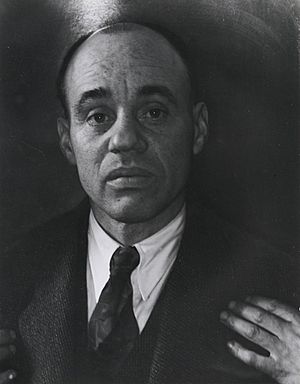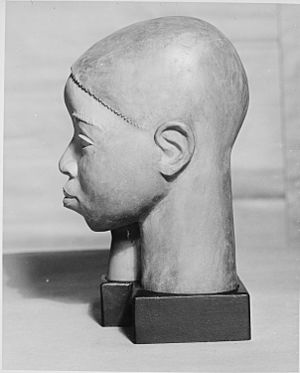Sargent Claude Johnson facts for kids
Quick facts for kids
Sargent Claude Johnson
|
|
|---|---|

Consuelo Kanaga, Sargent Johnson, 1934
|
|
| Born |
Sargent Claude Johnson
November 7, 1888 Boston, Massachusetts
|
| Died | October 10, 1967 (aged 78) San Francisco, California
|
| Nationality | American |
| Known for | Painting, sculpture, ceramics |
| Movement | left |
Sargent Claude Johnson (born November 7, 1888 – died October 10, 1967) was a very important American artist. He was one of the first African-American artists from California to become famous across the country. He was known for his unique styles, including Abstract Figurative and Early Modern art.
Johnson was a talented artist who worked in many ways. He was a painter, a potter, and a sculptor. He also made prints and graphic art. He used many different materials for his art. These included ceramics, clay, oil paints, stone, and wood. He also used terra-cotta and watercolor paints.
Early Life and Art Training
Sargent Johnson was the third of six children. His father was from Sweden, and his mother was African-American and Cherokee. His father passed away in 1897. Five years later, in 1902, his mother also died.
At age fifteen, Sargent and his siblings went to live with their uncle and aunt. Their aunt, May Howard Jackson, was a famous African-American sculptor. She made portrait busts, often showing Black people. She likely inspired Sargent Johnson when he was young.
Later, the boys in the family went to an orphanage. The girls went to a Catholic school. As adults, some of Sargent's siblings chose to live as Native Americans or Caucasians. But Sargent always identified as African American.
We don't know much about how Johnson became a professional artist. In 1915, he moved to the San Francisco Bay area. A big art event, the Panama–Pacific International Exposition, happened there soon after. This event greatly influenced art in California.
That same year, Sargent Johnson married Pearl Lawson. He began studying art at the A. W. Best School of Art. From 1919 to 1923, he attended the California School of Fine Arts. Here, he learned from famous sculptors like Beniamino Bufano.
A photographer named Consuelo Kanaga knew Johnson well. She said he had a beautiful spirit. She admired his way of talking, thinking, and working. She felt he was beautiful, even when he faced difficult problems.
Johnson's Art Career
Johnson made clever and detailed art. His work ranged from lively African masks to prints and small figures.
—Grace Glueck, 'The New York Times', 25 October 1996
Sargent Johnson started showing his art in 1926. He worked with the Harmon Foundation in New York. This foundation was known for supporting African-American artists. Through them, he showed many pieces and became famous.
At one show, 87 of his artworks were displayed. Johnson won a $150 prize for his best work. This included a porcelain head of a Black child named Pearl. He also showed two drawings, one called Defiant.
Johnson's art was often different from traditional Western art. He was inspired by other cultures, like Mexican muralists. These included Diego Rivera and José Clemente Orozco. Because of this, his work was not always seen as "American art."
In 1928, Johnson's award-winning art made him well-known. He gained fame among artists in the Harlem Renaissance movement.
In the late 1930s, Sargent Johnson worked with the Federal Art Project (FAP). He was part of the artistic community in San Francisco. He was also influenced by the New Negro Movement. His early art often explored ideas about racial identity.
Johnson's art is known for being simple, direct, and strong. He mostly focused on showing African Americans. He especially wanted to redefine how African-American women were seen.
Johnson once said he cared about showing the natural beauty of Black people. He wanted to highlight their unique features and dignity. He hoped to show this beauty to Black people themselves. He believed that Black people are colorful. He felt their art should be just as colorful.
After the 1940s, Johnson's art changed. It became less focused on racial themes and more abstract. But even with this change, the importance of racial identity could still be seen in his figures.
Johnson could not earn enough money from his art alone. So, he worked many different jobs during the day. He focused on his art in the evenings and on weekends. He continued to show his work in local exhibitions. He also took on private art projects to earn more money.
From 1945 to 1965, Sargent Johnson traveled to Oaxaca and Southern Mexico many times. He started to include the people and culture of Mexico in his art. He was especially interested in ancient Mexican art. Other subjects in his work included animals and Native Americans. During this time, Johnson also tried new materials like ceramics and paint.
Personal Life
In 1936, Johnson and his wife separated. Their only daughter, Pearl, went to live with her mother. In 1947, Johnson's former wife became very ill and was hospitalized. She passed away in 1964. Johnson remained friendly with her and visited her often.
His wife and family had a big impact on his art. Many of his pieces were about the people he loved. Johnson passed away at his home in California on October 10, 1967. He had a heart attack.
Images for kids



